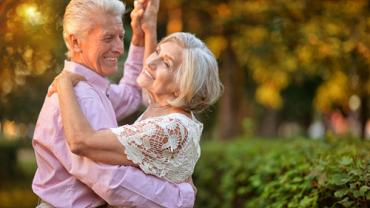
There’s more to health and happiness than following a good diet—a lot more. Whether someone cuts back on fat or carbs, goes Paleo or vegetarian, eating wholesome, nutritious foods only goes so far. Diet is important, of course, but it’s not everything. Physical activity, stress reduction, spending time in nature, watching a funny movie, or just curling up with a good book are other simple actions that have surprisingly powerful positive impacts on physical and mental health. Something else we can add to this list is dance. Admit it: it’s hard to feel down about anything when you’re gettin’ your boogie on!
Like any other performing art or creative act, dancing seems to be hard-wired into the human species. From the first time a caveman ever banged a stick against a boulder and created a beat, humans may have been pulled to move to the rhythm. Dance has been called “a positive and deeply humanizing experience.” We may not all rush to join the crowd on the wedding or bar mitzvah dance floor when the Macarena, YMCA, or the Chicken Dance plays, but each of us has a few songs that make it almost impossible to sit still. Don’t pretend you haven’t shaken and shimmied in your car when your favorite song plays at a red light! You know you have!
As a form of aerobic exercise—some forms more vigorous than others—dance may be a positive health intervention for people of all ages, but it’s especially beneficial for older individuals. Older people may have an easier time dancing than engaging in forms of exercise that require more impact on the joints, such as running or tennis. Of course, this depends on the type of dancing, because if you’ve ever watched a professional ballroom competition, then you know some of those dances might as well be a triathlon!
An analysis of studies looking at the influence of dance on healthy aging found that, as a general rule, dancing resulted in cardiometabolic improvements and improved balance. The studies were heterogeneous and included evaluations of various different types of dance and different subject cohorts: post-menopausal women, obese adults, frail older adults, those with chronic heart failure, Parkinson’s patients, and more. It’s difficult to tease out the exact effects one particular type of dance might have on one particular individual, but considering the physical and social aspects of dance, it’s hard not to imagine it reaping benefits, including subjective ones like emotional wellbeing, which isn’t easy to quantify and measure. Loneliness and isolation are major factors in poor health, especially among the elderly, so if participation in some kind of dance organization or event helps older people stay socially connected in their community, that alone would make it worth it.
By helping to maintain healthy insulin sensitivity and proper blood glucose control, physical activity—such as dance—may play a role in warding off dementia and cognitive decline. Individuals who engage in physical activity tend to maintain brain volume as they age, compared to those who remain more inactive. One of the hallmarks of Alzheimer’s disease is reduced hippocampal volume and shrinkage of other brain regions. Higher amounts of physical activity and caloric expenditure are associated with larger gray matter volumes in the elderly.
Dancing may provide increased benefits for older people compared to other forms of physical activity. A study that compared a dance intervention to interventions with walking or a cycle ergometer and resistance training found that for older adults, the “fitness sport” (walking or cycling) intervention and the dance intervention both resulted in increases in certain hippocampal regions, but individuals in the dance group had increases in other regions and also showed significant increases in the composite score for balance, while the fitness sport cohort did not. The study authors wrote, “both dance and fitness training can induce hippocampal plasticity in the elderly, but only dance training improved balance capabilities.”
In the age of epidemics of obesity, type 2 diabetes and cardiovascular disease, improving balance may not seem like something worth celebrating, but considering the impact on quality of life if an older person takes a bad fall, it’s not overstating the case to say that good balance can mean the difference between someone living independently or requiring assistance or institutionalization.
The researchers also speculate there may be an additional benefit of dance where cognition is concerned: besides just being good exercise, mastering new dance steps and routines to different types of music meant that participants were constantly learning and potentially forging new neuronal connections, as opposed to the monotony of riding an indoor cycle. According to the lead author:
“We tried to provide our seniors in the dance group with constantly changing dance routines of different genres (Jazz, Square, Latin-American and Line Dance). Steps, arm-patterns, formations, speed and rhythms were changed every second week to keep them in a constant learning process. The most challenging aspect for them was to recall the routines under the pressure of time and without any cues from the instructor.”
A systematic review of dance interventions for older adults found that, overall, dance leads to significant positive changes in muscular strength and endurance, flexibility, balance, cognitive ability, and cardiovascular endurance. Not bad for something that people generally enjoy doing anyway. Compared to forms of exercise that some people may think of as a “chore,” for example, jogging, dance may be a kind of physical activity people actually look forward to! And while the sports science and kinesiology experts can argue about the finer points of one type of activity versus another, most of them would agree that the best exercise is the one someone will actually do.
The verdict is in: “Undertaking structured dance of any genre is equally and occasionally more effective than other types of structured exercise for improving a range of health outcome measures. Health practitioners can recommend structured dance as a safe and effective exercise alternative.”
By Amy Berger, MS, CNS